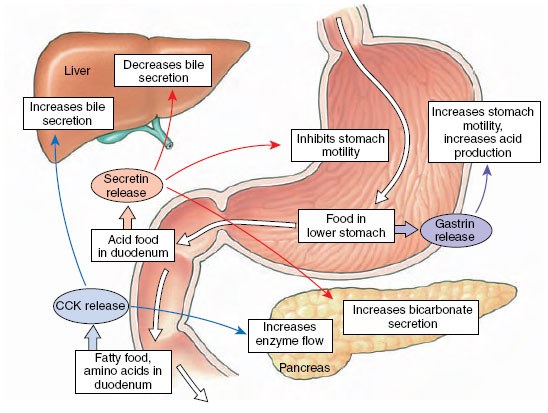Regulation of Digestion
Regulation of Digestion
The digestive process is coordinated by a family of hormones (see Chemical Coordination) produced by the body’s most diffuse endocrine tissue, the gastrointestinal tract. These hormones are examples of the many substances produced by the vertebrate body that have hormonal function, yet are not necessarily produced by discrete endocrine glands. Because of their diffuse origins the gastrointestinal (GI) hormones have been difficult to isolate and study and only recently have they been researched in depth.
Among the principal GI hormones are gastrin, cholecystokinin (CCK), and secretin (Figure 34-15). Gastrin is a small polypeptide hormone produced by endocrine cells in the pyloric portion of the stomach. Gastrin is secreted in response to stimulation by the parasympathetic nerve endings, and when protein food enters the stomach. Its main actions are to stimulate hydrochloric acid secretion and to increase gastric motility. Gastrin is an unusual hormone in that it exerts its action on the same organ from which it is secreted. CCK is also a polypeptide hormone, and it has a striking structural resemblance to gastrin, suggesting that the two arose by duplication of ancestral genes. CCK is secreted by endocrine cells in the walls of the upper small intestine in response to the presence of fatty acids and amino acids in the duodenum. It has at least three distinct functions. It stimulates gallbladder contraction and thus increases the flow of bile salts into the intestine; it stimulates an enzyme-rich secretion from the pancreas; and it acts on the brain to contribute a feeling of satiety after a meal, particularly one rich in fats. The first hormone to be discovered, secretin (see the opening essay for on), is produced by endocrine cells in the duodenal wall. It is secreted in response to food and strong acid in the stomach and small intestine, and its principal action is to stimulate the release of an alkaline pancreatic fluid that neutralizes stomach acid as it enters the intestine. It also aids fat digestion by inhibiting gastric motility and increasing production of an alkaline bile secretion from the liver.
GI hormones continue to be isolated and their structure determined. So far, all are peptides, and many are present in both the GI tract and in the central nervous system. One of these is CCK, which has been found in high concentrations in the cerebral cortex and hypothalamus of mammals. By providing a feeling of satiety after eating (mentioned above) it may play some role in regulating appetite. Several other GI peptides, for example, vasoactive intestinal peptide (VIP) and gastric inhibitory peptide (GIP) appear to play neurotransmitter roles in the brain. This unexpected versatility has served to broaden our concept of hormones as molecules capable of functioning in several different ways.
The digestive process is coordinated by a family of hormones (see Chemical Coordination) produced by the body’s most diffuse endocrine tissue, the gastrointestinal tract. These hormones are examples of the many substances produced by the vertebrate body that have hormonal function, yet are not necessarily produced by discrete endocrine glands. Because of their diffuse origins the gastrointestinal (GI) hormones have been difficult to isolate and study and only recently have they been researched in depth.
 |
| Figure 34-15 Three hormones of digestion. Shown are the principal actions of the hormones gastrin, CCK (cholecystokinin), and secretin. |
Among the principal GI hormones are gastrin, cholecystokinin (CCK), and secretin (Figure 34-15). Gastrin is a small polypeptide hormone produced by endocrine cells in the pyloric portion of the stomach. Gastrin is secreted in response to stimulation by the parasympathetic nerve endings, and when protein food enters the stomach. Its main actions are to stimulate hydrochloric acid secretion and to increase gastric motility. Gastrin is an unusual hormone in that it exerts its action on the same organ from which it is secreted. CCK is also a polypeptide hormone, and it has a striking structural resemblance to gastrin, suggesting that the two arose by duplication of ancestral genes. CCK is secreted by endocrine cells in the walls of the upper small intestine in response to the presence of fatty acids and amino acids in the duodenum. It has at least three distinct functions. It stimulates gallbladder contraction and thus increases the flow of bile salts into the intestine; it stimulates an enzyme-rich secretion from the pancreas; and it acts on the brain to contribute a feeling of satiety after a meal, particularly one rich in fats. The first hormone to be discovered, secretin (see the opening essay for on), is produced by endocrine cells in the duodenal wall. It is secreted in response to food and strong acid in the stomach and small intestine, and its principal action is to stimulate the release of an alkaline pancreatic fluid that neutralizes stomach acid as it enters the intestine. It also aids fat digestion by inhibiting gastric motility and increasing production of an alkaline bile secretion from the liver.
GI hormones continue to be isolated and their structure determined. So far, all are peptides, and many are present in both the GI tract and in the central nervous system. One of these is CCK, which has been found in high concentrations in the cerebral cortex and hypothalamus of mammals. By providing a feeling of satiety after eating (mentioned above) it may play some role in regulating appetite. Several other GI peptides, for example, vasoactive intestinal peptide (VIP) and gastric inhibitory peptide (GIP) appear to play neurotransmitter roles in the brain. This unexpected versatility has served to broaden our concept of hormones as molecules capable of functioning in several different ways.




